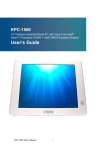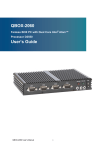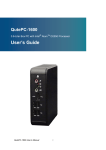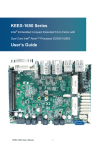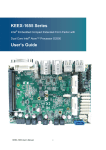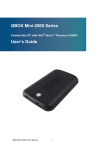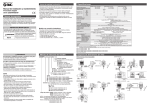Download Quanmax HPC-1010 User`s guide
Transcript
HPC-1010 10.1”Fanless Panel PC w/ Dual Core Intel® Atom™ Processor N2800 User’s Guide HPC-1010 User’s Manual I Contact Info: Quanmax Inc. 5F, No. 415, Ti-Ding Blvd. Sec. 2, NeiHu District, Taipei, Taiwan 114 Tel: +886-2-2799-2789 Fax: +886-2-2799-7399 Visit our site at: www.quanmax.com © 2012 Quanmax Inc. All rights reserved. The information in this user’s guide is provided for reference only. Quanmax does not assume any liability arising out of the application or use of the information or products described herein. This user’s guide may contain or reference information and products protected by copyrights or patents and does not convey any license under the patent rights of Quanmax, nor the rights of others. Quanmax is a registered trademark of Quanmax. All trademarks, registered trademarks, and trade names used in this user’s guide are the property of their respective owners. All rights reserved. This user’s guide contains information proprietary to Quanmax. Customers may reprint and use this user’s guide in other publications. Customers may alter this user’s guide and publish it only after they remove the Quanmax name, cover, and logo. Quanmax reserves the right to make changes without notice in product or component design as warranted by evolution in user needs or progress in engineering or manufacturing technology. Changes which affect the operation of the unit will be documented in the next revision of this user’s guide. HPC-1010 User’s Manual II Content Content Content....................................................................................................................... 3 Figures & Tables......................................................................................................... 4 Safety Instructions ...................................................................................................... 5 Before You Begin .................................................................................. 5 When Working Inside a Computer ........................................................ 6 Preventing Electrostatic Discharge ....................................................... 7 Instructions for Lithium Battery ............................................................. 7 Preface ....................................................................................................................... 8 How to Use This Guide ......................................................................... 8 Unpacking ............................................................................................. 8 Regulatory Compliance Statements ...................................................... 8 Warranty Policy ..................................................................................... 9 Maintaining Your Computer................................................................. 10 Chapter 1 Introduction ........................................................................................... 13 Overview ............................................................................................. 13 Product Specifications ........................................................................ 14 System tour......................................................................................... 15 Mechanical Dimensions ...................................................................... 17 Chapter 2 Getting Started ...................................................................................... 18 Setting up your PC .............................................................................. 18 VESA Mounting................................................................................... 22 Wall Mount Kit ..................................................................................... 23 Desktop Stand .................................................................................... 24 Operating System and Drivers ............................................................ 25 Maintenance and Prevention .............................................................. 25 Chapter 3 AMI BIOS Setup.................................................................................... 26 Overview ............................................................................................. 26 Main Menu .......................................................................................... 27 Advanced Menu .................................................................................. 28 Boot Menu .......................................................................................... 35 Security Menu ..................................................................................... 36 Save & Exit Menu ............................................................................... 36 Chapter 4 D river Installation .................................................................................. 38 HPC-1010 User’s Manual 3 Figures & Tables Figures & Tables Figure 1 I/Os .............................................................................................. 15 Figure 2 Mechanical Dimensions ............................................................... 17 Figure 3 DVI- I/ HDMI ................................................................................ 18 Figure 4 Connect USB mouse & keyboard ................................................ 19 Figure 5 RJ45 connector ............................................................................ 19 Figure 6 COM port ..................................................................................... 20 Figure 7 Turning on the system ................................................................. 21 Figure 8 VESA Mounting Hole Locations ................................................... 22 Figure 9 Wall Mounting Demonstrations .................................................... 23 Figure 10 Install Desktop Stand ................................................................. 24 Table 1 HPC-1010 product specification .................................................... 14 Table 2 BIOS Main Menu ........................................................................... 27 Table 3 Advanced Menu ............................................................................. 28 Table 4 Advanced Menu – Display Configuration ....................................... 29 Table 5 Advanced Menu –Power Management Configuration.................... 30 Table 6 Advanced Menu –CPU Advanced Configuration ........................... 31 Table 7 Advanced Menu –SATA Configuration ........................................... 32 Table 8 Advanced Menu –USB Configuration ............................................ 32 Table 9 Advanced Menu – Super IO Configuration .................................... 33 Table 10 Advanced Menu – Super IO Configuration – Serial Port 1 Configuration ............................................................................. 33 Table 11 Advanced Menu –H/W Monitor .................................................... 34 Table 12 Boot Menu ................................................................................... 35 Table 13 Security Menu ............................................................................. 36 Table 14 Save & Exit Menu ........................................................................ 36 HPC-1010 User’s Manual 4 Safety Instructions Safety Instructions Before You Begin Before handling the product, read the instructions and safety guidelines on the following pages to prevent damage to the product and to ensure your own personal safety. Refer to the “Advisories” section in the Preface for advisory conventions used in this user’s guide, including the distinction between Warnings, Cautions, Important Notes, and Notes. Always use caution when handling/operating a computer. Only qualified, experienced, authorized electronics service personnel should access the interior of a computer. The power supplies produce high voltages and energy hazards, which can cause bodily harm. Use extreme caution when installing or removing components. Refer to the installation instructions in this user’s guide for precautions and procedures. If you have any questions, please contact Quanmax Post-Sales Technical Support. Access can only be gained by service persons or by users who have been instructed about the reasons for the restrictions applied to the location and about any precautions that shall be taken; and access is through the use of a tool or lock and key, or other means of security, and is controlled by authority responsible for the location. WARNING High voltages are present inside the chassis when the unit’s power cord is plugged into an electrical outlet. Turn off system power, turn off the power supply, and then disconnect the power cord from its source before removing the chassis cover. Turning off the system power switch does not remove power to components. HPC-1010 User’s Manual 5 Safety Instructions When Working Inside a Computer Before taking covers off a computer, perform the following steps: 1. Turn off the computer and any peripherals. 2. Disconnect the computer and peripherals from their power sources or subsystems to prevent electric shock or system board damage. This does not apply when hot swapping parts. 3. Follow the guidelines provided in “Preventing Electrostatic Discharge” on the following page. 4. Disconnect any telephone or telecommunications lines from the computer. In addition, take note of these safety guidelines when appropriate: To help avoid possible damage to system boards, wait five seconds after turning off the computer before removing a component, removing a system board, or disconnecting a peripheral device from the computer. When you disconnect a cable, pull on its connector or on its strain-relief loop, not on the cable itself. Some cables have a connector with locking tabs. If you are disconnecting this type of cable, press in on the locking tabs before disconnecting the cable. As you pull connectors apart, keep them evenly aligned to avoid bending any connector pins. Also, before connecting a cable, make sure both connectors are correctly oriented and aligned. CAUTION Do not attempt to service the system yourself except as explained in this user’s guide. Follow installation and troubleshooting instructions closely. HPC-1010 User’s Manual 6 Safety Instructions Preventing Electrostatic Discharge Static electricity can harm system boards. Perform service at an ESD workstation and follow proper ESD procedure to reduce the risk of damage to components. Quanmax strongly encourages you to follow proper ESD procedure, which can include wrist straps and smocks, when servicing equipment. You can also take the following steps to prevent damage from electrostatic discharge (ESD): When unpacking a static-sensitive component from its shipping carton, do not remove the component’s antistatic packing material until you are ready to install the component in a computer. Just before unwrapping the antistatic packaging, be sure you are at an ESD workstation or grounded. This will discharge any static electricity that may have built up in your body. When transporting a sensitive component, first place it in an antistatic container or packaging. Handle all sensitive components at an ESD workstation. If possible, use antistatic floor pads and workbench pads. Handle components and boards with care. Don’t touch the components or contacts on a board. Hold a board by its edges or by its metal mounting bracket. Do not handle or store system boards near strong electrostatic, electromagnetic, magnetic, or radioactive fields. Instructions for Lithium Battery WARNING Danger of explosion when battery is replaced with incorrect type. Only replace with the same or equivalent type recommended by the manufacturer. Do not dispose of lithium batteries in domestic waste. Dispose of the battery according to the local regulations dealing with the disposal of these special materials (e.g. to the collecting points for disposal of batteries) HPC-1010 User’s Manual 7 Preface Preface How to Use This Guide This guide is designed to be used as step-by-step instructions for installation, and as a reference for operation, troubleshooting, and upgrades. NOTE Driver downloads and additional information are available under Downloads on our web site: www.quanmax.com. Unpacking When unpacking, follow these steps: 1. After opening the box, save it and the packing material for possible future shipment. 2. Remove all items from the box. If any items listed on the purchase order are missing, notify Quanmax customer service immediately. 3. Inspect the product for damage. If there is damage, notify Quanmax customer service immediately. Refer to “Warranty Policy” for the return procedure. Regulatory Compliance Statements This section provides the FCC compliance statement for Class A devices. FCC Compliance Statement: This equipment has been tested and found to comply with limits for a Class A digital device, pursuant to Part 15 of the FCC rules. These limits are designed to provide reason able protection against harmful interference in residential installations. This equipment generates, uses, and can radiate radiofrequency energy, and if not installed and used in accordance with the instructions, may cause harmful interference to radio communications. However, there is no guarantee that interference will not occur in a particular installation. If this equipment does cause HPC-1010 User’s Manual 8 Preface interference to radio or television equipment reception, which can be determined by turning the equipment off and on, the user is encouraged to try to correct the interference by one or more of the following measures: Reorient or relocate the receiving antenna. Increase the separation between the equipment and receiver. Connect the equipment to an outlet on a circuit different from that to which the receiver is connected. Consult the dealer or an experienced radio/TV technician for help. Changes or modifications not expressly approved by Quanmax could void the user's authority to operate the equipment. NOTE The assembler of a personal computer system may be required to test the system and/or make necessary modifications if a system is found to cause harmful interference or to be noncompliant with the appropriate standards for its intended use. Warranty Policy Limited Warranty Quanmax Inc.’s detailed Limited Warranty policy can be found under Support at www.quanmax.com. Please consult your distributor for warranty verification. The limited warranty is void if the product has been subjected to alteration, neglect, misuse, or abuse; if any repairs have been attempted by anyone other than Quanmax or its authorized agent; or if the failure is caused by accident, acts of God, or other causes beyond the control of Quanmax or the manufacturer. Neglect, misuse, and abuse shall include any installation, operation, or maintenance of the product other than in accordance with the user’s guide. No agent, dealer, distributor, service company, or other party is authorized to change, modify, or extend the terms of this Limited Warranty in any manner whatsoever. Quanmax reserves the right to make changes or improvements in any product without incurring any obligation to similarly alter products previously purchased. Return Procedure For any Limited Warranty return, please contact Support at www.quanmax.com and login to obtain a Return Material Authorization (RMA) Number. If you do not have an HPC-1010 User’s Manual 9 Preface account, send an email to [email protected] to apply for one. All product(s) returned to Quanmax for service or credit must be accompanied by a Return Material Authorization (RMA) Number. Freight on all returned items must be prepaid by the customer who is responsible for any loss or damage caused by common carrier in transit. Returns for Warranty must include a Failure Report for each unit, by serial number(s), as well as a copy of the original invoice showing the date of purchase. To reduce risk of damage, returns of product must be in a Quanmax shipping container. If the original container has been lost or damaged, new shipping containers may be obtained from Quanmax Customer Service at a nominal cost. Quanmax owns all parts removed from repaired products. Quanmax uses new and reconditioned parts made by various manufacturers in performing warranty repairs and building replacement products. If Quanmax repairs or replaces a product, its warranty term is not extended. Shipments not in compliance with this Limited Warranty Return Policy will not be accepted by Quanmax. Limitation of Liability In no event shall Quanmax be liable for any defect in hardware, software, loss, or inadequacy of data of any kind, or for any direct, indirect, incidental, or consequential damages in connection with or arising out of the performance or use of any product furnished hereunder. Quanmax’s liability shall in no event exceed the purchase price of the product purchased hereunder. The foregoing limitation of liability shall be equally applicable to any service provided by Quanmax or its authorized agent. Maintaining Your Computer Environmental Factors Temperature The ambient temperature within an enclosure may be greater than room ambient temperature. Installation in an enclosure should be such that the amount of air flow required for safe operation is not compromised. Consideration should be given to the maximum rated ambient temperature. Overheating can cause a variety of problems, including premature aging and failure of chips or mechanical failure of devices. If the system has been exposed to abnormally cold temperatures, allow a two-hour warm-up period to bring it up to normal operating temperature before HPC-1010 User’s Manual 10 Preface turning it on. Failure to do so may cause damage to internal components, particularly the hard disk drive. Humidity High-humidity can cause moisture to enter and accumulate in the system. This moisture can cause corrosion of internal components and degrade such properties as electrical resistance and thermal conductivity. Extreme moisture buildup inside the system can result in electrical shorts, which can cause serious damage to the system. Buildings in which climate is controlled usually maintain an acceptable level of humidity for system equipment. However, if a system is located in an unusually humid location, a dehumidifier can be used to maintain the humidity within an acceptable range. Refer to the “Specifications” section of this user’s guide for the operating and storage humidity specifications. Power Protection The greatest threats to a system’s supply of power are power loss, power spikes, and power surges caused by electrical storms, which interrupt system operation and/or damage system components. To protect your system, always properly ground power cables and one of the following devices. Surge Protector Surge protectors are available in a variety of types and usually provide a level of protection proportional with the cost of the device. Surge protectors prevent voltage spikes from entering a system through the AC power cord. Surge protectors, however, do not offer protection against brownouts, which occur when the voltage drops more than 20 percent below the normal AC line voltage level. Line Conditioner Line conditioners go beyond the overvoltage protection of surge protectors. Line conditioners keep a system’s AC power source voltage at a fairly constant level and, therefore, can handle brownouts. Because of this added protection, line conditioners cost more than surge protectors. However, line conditioners cannot protect against a complete loss of power. HPC-1010 User’s Manual 11 Preface Uninterruptible Power Supply Uninterruptible power supply (UPS) systems offer the most complete protection against variations on power because they use battery power to keep the server running when AC power is lost. The battery is charged by the AC power while it is available, so when AC power is lost, the battery can provide power to the system for a limited amount of time, depending on the UPS system. UPS systems range in price from a few hundred dollars to several thousand dollars, with the more expensive unit s allowing you to run larger systems for a longer period of time when AC power is lost. UPS systems that provide only 5 minutes of battery power let you conduct an orderly shutdown of the system, but are not intended to provide continued operation. Surge protectors should be used with all UPS systems, and the UPS system should be Underwriters Laboratories (UL) safety approved. HPC-1010 User’s Manual 12 Chapter 1 Chapter 1 Introduction Overview The HPC-1010 10.1” Panel PC is combining the Intel® Atom™ processor N2800 with the high integration of the Intel® NM10 Express chipset for a wide range of industrial applications. Storage includes a 2.5" SATA hard drive or a solid-state drive (SSD). Supported interfaces include 2x GbE LAN, 1x COM port, 6x USB 2.0 ports, 1x SATA,1x HDMI, 1x DVI-I thus easily meeting a broad range of customer requirements. The HPC series provide a compact, high performance human-machine interface for home automation demands. Checklist HPC-1010 Power Adapter Power Cord Driver CD Quick installation Guide Optional VESA Mounting Kit Optional wireless LAN Optional RFID Features 10.1” LCD Display with 1024 x 600 resolution Intel® Atom™ Processor N2800/ Intel® NM10 Express Chipset Intel® Graphics Media Accelerator 3650 DDR3 800/1066MHz memory support up to 4GB 1x HDMI, 1x DVI-I 6x USB2.0, 1x COM, 2x GbE LAN, 1x SATA 1x Mini-PCIe slot supported Fanless design HPC-1010 User’s Manual 13 Chapter 1 Product Specifications CPU Support ® Intel Atom™ Processor N2800 (1M Cache, 1.86 GHz) Chipset ® Intel NM10 Express chipset Memory 1x Single Channel DDR3 800/1066MHz SODIMM support (4GB max) BIOS Graphic Touch Sensor AMI Plug & Play SPI BIOS ® Intel Graphics Media Accelerator 3650 5-wire resistive touch sensor Size: 10.1inch, 16:9 LCD Display Resolution: 1024 x 600 Backlight: LED Contrast Ratio: 500:1 (typical) Brightness: 200cd/m2 (typical) External Display 1x HDMI 1x DVI-I LAN 2x Gigabit Ethernet (Realtek RTL8111E) PXE/WOL supported Audio Realtek ALC662 HD Codec w/ 2W Audio Amplifier Line-In, Line-Out and Mic-In Supported Storage 1x 2.5” SATA HDD or SSD space USB 6x USB 2.0 COM 1x COM port with RS-232/422/485 selection supported Expansion slot Hardware Monitor Watchdog Timer Power 1x Mini-PCIe slot Operating voltage, CPU temperature 1-255 step, can be set with software on Super I/O DC 12V Input OS Support Window 7 Dimensions 261.98 x 199.98 x 61mm (WxDxH) Environment Operating Temperature: With Industrial SSD: -10 ~ 50° C (Ambient with air flow) With 2.5" HDD: 0 ~ 40° C (Ambient with air flow) Storage Temperature: Certification -20°C to 80°C, 0%-90%, non-condensing CE, FCC Class A Table 1 HPC-1010 product specification HPC-1010 User’s Manual 14 Chapter 1 System tour Refer to the diagrams below to identify the components of the system. I/Os Figure 1 I/Os USB The USB (Universal Serial Bus) port is compatible with USB devices such as keyboards, mouse devices, cameras, and hard disk drives. USB allows many devices to run simultaneously on a single computer, with some peripheral acting as additional plug-in sites or hubs. Power Button The power button allows powering ON and OFF the system. Ethernet The eight-pin RJ-45 LAN port supports a standard Ethernet cable for connection to a local network. HPC-1010 User’s Manual 15 Chapter 1 DC Jack The supplied power adapter converts AC power to DC for use with this jack. Power supplied through this jack supplies power to the PC. To prevent damage to the PC, always use the supplied power adapter. HDMI HDMI connector for display output COM D-Sub 9 pin connector for RS-232/422/485 connection DVI-I The DVI-I (Digital Visual Interface-Integrated) connector allows you to connect an LCD monitor. It provides a high-speed digital interconnection between the computer and its display device. HPC-1010 User’s Manual 16 Chapter 1 Mechanical Dimensions 261.98 x 199.98 x 61 mm ( W x D x H ) Figure 2 Mechanical Dimensions HPC-1010 User’s Manual 17 Chapter 2 Chapter 2 Getting Started Setting up your PC Connecting the monitor Connect the HDMI / DVI-I cable from your display to the HDMI / DVI-I port. HDMI DVI-I Figure 3 DVI- I/ HDMI HPC-1010 User’s Manual 18 Chapter 2 Connecting USB mouse & keyboard Your HPC-1010 does not come with a keyboard and mouse, but you can use any USB keyboard or mouse with your computer. USB USB Figure 4 Connect USB mouse & keyboard NOTE Using a third-party USB mouse or keyboard may require software drivers. Check the manufacturer’s website for the latest software drivers. Connecting to a network device Connect one end of a network cable to the LAN port on the system rear panel and the other end to a hub or switch. LAN Figure 5 RJ45 connector HPC-1010 User’s Manual 19 Chapter 2 COM port COM port with the pin definitions. COM COM1RS-232 / 422 / 485 Port DB-9 TXRX+ TX+ RXGND N/A N/A N/A Half Duplex RS-485 DATAN/A DATA+ N/A GND N/A N/A N/A Full Duplex RS-485 TXRX+ TX+ RXGND N/A N/A N/A RI RI RI Pin RS-232 RS-422 1 2 3 4 5 6 7 8 DCD RXD TXD DTR GND DSR RTS CTS 9 RI Figure 6 COM port HPC-1010 User’s Manual 20 Chapter 2 Turning on the system 1. 2. 3. 4. Connect the power adapter cable to the DC jack (DC IN) of the HPC-1010 Connect the power cable to the power adapter Connect the power cable to a power outlet Press the power switch on the front panel to turn on the system Power button DC Jack Figure 7 Turning on the system HPC-1010 User’s Manual 21 Chapter 2 VESA Mounting The product comes with VESA FDMI 75 standard mounting holes as shown below. Use 4 screws with the appropriate length for your mounting bracket. Figure 8 VESA Mounting Hole Locations NOTE To fasten the metal shelf, your monitor must comply with VESA75 standard. The VESA mounting kit is optional. HPC-1010 User’s Manual 22 Chapter 2 Wall Mount Kit Below are the demonstrations of how to use Quanmax wall-mount kits Step1 Secure the VESA kit to the panel PC using the 4 screws. (M4x5L flat head) Step2 Install the wall-mount kit to the proper place of the wall by using the 6 screws. Step3 Attach the panel PC to the wall-mount kit which has been well fixed on the wall. Step4 Secure the wall-mount kit and panel PC with screw by using Phillips Screwdriver Figure 9 Wall Mounting Demonstrations HPC-1010 User’s Manual 23 Chapter 2 Desktop Stand Step1 Assembling the desktop stand Step2 Secure the VESA kit to the desktop stand using the 4 screws. (M4x5L round head) Step3 Secure the panel PC to the desktop stand using the 4 screws. (M4x5L flat head) Figure 10 Install Desktop Stand HPC-1010 User’s Manual 24 Chapter 2 Operating System and Drivers If your product does not come with an operating system pre-installed, you will need to install an operating system and the necessary drivers to operate it. After you have finished assembling your system and connected the appropriate power source, power it up using the power supply and install the desired operating system. You can download the drivers for the product from the Quanmax website at www.quanmax.com and install as instructed there. For other operating systems, please contact Quanmax. NOTE 1. To install the VGA driver, please double-click “Setup.exe” which is under below folder. \Intel VGA\Utilities 2. If your system goes into suspend mode, please push the power button for 2 seconds to wake up the system. Maintenance and Prevention Your HPC-1010 system requires minimal maintenance and care to keep it operating correctly. Occasionally wipe the system with a soft dry cloth. You should only remove persistent dirt by use of a soft, slightly damp cloth (use only a mild detergent). Make sure the ventilation holes are clear of debris. CAUTION Do NOT do any of the following: Allow water to enter the computer Use a heavily dampened cloth Spray water directly inside of computer HPC-1010 User’s Manual 25 Chapter 3 Chapter 3 AMI BIOS Setup Overview This chapter provides a description of the AMI BIOS. The BIOS setup menus and available selections may vary from those of your product. For specific information on the BIOS for your product, please contact Quanmax. NOTE: The BIOS menus and selections for your product may vary from those in this chapter. For the BIOS manual specific to your product, please contact Quanmax AMI's ROM BIOS provides a built-in Setup program, which allows the user to modify the basic system configuration and hardware parameters. The modified data will be stored in a battery-backed CMOS, so that data will be retained even when the power is turned off. In general, the information saved in the CMOS RAM will not need to be changed unless there is a configuration change in the system, such as a hard drive replacement or when a device is added. It is possible for the CMOS battery to fail, which will cause data loss in the CMOS only. If this happens you will need to reconfigure your BIOS settings. HPC-1010 User’s Manual 26 Chapter 3 Main Menu The BIOS Setup is accessed by pressing the DEL key after the Power-On Self-Test (POST) memory test begins and before the operating system boot begins. Once you enter the BIOS Setup Utility, the Main Menu will appear on the screen. The Main Menu provides System Overview information and allows you to set the System Time and Date. Use the “<” and “>” cursor keys to navigate between menu screens. Table 2 BIOS Main Menu BIOS SETUP UTILITY Main Advanced Boot Security Save & Exit Product Information Product Name HPC-1010 BIOS Version 1.00 BIOS Build Date 07/23/2012 CPU Information Intel® Atom™ CPU [email protected] Microcode Revision 10d Processor Cores 2 Select Screen Memory Information ↑↓ Select Item Total Size 1024 MB Frequency 1067 MHz (DDR3) System date [Sun 11/20/2011] System time [14:33:56] Enter: Select +- Change Opt. F1: General Help F2: Previous Values F3: Optimized Defaults F4 Save & Exit ESC Exit Version 2.14.1219. Copyright (C) 2011, American Megatrends, Inc. HPC-1010 User’s Manual 27 Chapter 3 Advanced Menu Table 3 Advanced Menu BIOS SETUP UTILITY Main Advanced Boot Security Server M gmt Save & Onboard LAN1 Controller [Enabled] Onboard LAN1 Boot [Disabled] Onboard LAN2 Controller [Enabled] Onboard LAN2 Boot [Disabled] Select Screen Audio Controller [Enabled] ↑↓ Select Item Enter: Select +- Change Opt. > Display Configuration > Power Management Configuration F1: General Help > CPU Advanced Configuration > SATA Configuration > USB Configuration > Super IO Configuration > H/W Monitor F2: Previous Values F3: Optimized Defaults F4 Save & Exit ESC Exit Version 2.14.1219. Copyright (C) 2011, American Megatrends, Inc. Onboard LAN 1 Controller Options: Disabled, Enabled Onboard LAN 1 Boot Options: Disabled, Enabled Onboard LAN 2 Controller Options: Disabled, Enabled Onboard LAN 2 Boot Options: Disabled, Enabled Audio Controller Options: Disabled, Enabled HPC-1010 User’s Manual 28 Exit Chapter 3 Table 4 Advanced Menu – Display Configuration BIOS SETUP UTILITY Main Advanced Boot Security Display Configuration Server M gmt Save & Select Screen Fixed Graphics Memory Size [128 MB] IGFX – Boot Type [VBIOS Default] Active LFP [ Int-LVDS] +- Change Opt. [1024X600 18Bit 1CH] [2.5V] F1: General Help LCD Panel Type LVDS Backlight Control – Voltage M ↑↓ Select Item Enter: Select F2: Previous Values F3: Optimized Defaults F4 Save & Exit ESC Exit Version 2.14.1219. Copyright (C) 2011, American Megatrends, Inc. Fixed Graphics Memory Size Options: 128MB, 256MB IGFX – Boot Type Options: VBIOS Default, CRT, DVI, HDMI, LVDS LVDS Backlight Control – Voltage Options: 0.0V, 0.5V, 1.0V, 1.5V, 2.0V, 2.5V, 3.0V, 3.5V, 4.0V, 4.5V, 5.0V HPC-1010 User’s Manual 29 Exit Chapter 3 Table 5 Advanced Menu –Power Management Configuration BIOS SETUP UTILITY Main Advanced Boot Security Server M gmt Save & Power Management Configuration ACPI Sleep State [S3 (Suspend to RAM)] Restore AC Power Loss Resume From S3 By PS/2 Keyboard Resume From S3 By PS/2 Mouse [Power Off] [Disabled] [Disabled] Resume By PCIE Device Resume By RTC Alarm [Disabled] [Disabled] Select Screen ↑↓ Select Item Enter: Select +- Change Opt. F1: General Help F2: Previous Values >Watchdog Timer Configuration F3: Optimized Defaults F4 Save & Exit ESC Exit Version 2.14.1219. Copyright (C) 2011, American Megatrends, Inc. ACPI Sleep State Options: Suspend Disabled, S1 (CPU Stop Clock), S3 (Suspend to RAM) Restore AC Power Loss Options: Power Off, Power On, Last State Resume From S3 By PS/2 Keyboard Options: Disabled, Enabled Resume From S3 By PS/2 Mouse Options: Disabled, Enabled Resume By PCIE Device Options: Disabled, Enabled Resume By RTC Alarm Options: Disabled, Enabled Watchdog Timer Configuration ■ WDT Function [ Disabled ] Options: Disabled, Enabled HPC-1010 User’s Manual 30 Exit Chapter 3 Table 6 Advanced Menu –CPU Advanced Configuration BIOS SETUP UTILITY Main Advanced Boot Security Save & CPU Advanced Configuration Hyper-Treading [Enabled] Execute Disable Bit [Enabled] Limit CPUID Maximum EIST [Disabled] [Enabled] Select Screen ↑↓ Select Item Enter: Select +- Change Opt. F1: General Help F2: Previous Values F3: Optimized Defaults F4 Save & Exit ESC Exit Version 2.14.1219. Copyright (C) 2011, American Megatrends, Inc. Hyper-Treading Options: Disabled, Enabled Execute Disable Bit Options: Disabled, Enabled Limit CPUID Maximum Options: Disabled, Enabled EIST Options: Disabled, Enabled HPC-1010 User’s Manual 31 Exit Chapter 3 Table 7 Advanced Menu –SATA Configuration BIOS SETUP UTILITY Main Boot Advanced Security Save & Exit Select Screen Configure SATA as ↑↓ Select Item [ AHCI ] SATA Port 1 SATA Port 2 TOSHIBA MK8046 (80.0G) Not Present Enter: Select +- Change Opt. F1: General Help F2: Previous Values F3: Optimized Defaults F4 Save & Exit ESC Exit Version 2.14.1219. Copyright (C) 2011, American Megatrends, Inc. Configure SATA as Options: IDE, AHCI Table 8 Advanced Menu –USB Configuration BIOS SETUP UTILITY Main Advanced Boot Security USB Configuration Save & . USB Devices: Select Screen 1 Drive, 1 Keyboard Legacy USB Support [Enabled] EHCI Hand-off [Disabled] Mass Storage Devices: San Disk ↑↓ Select Item Enter: Select +- Change Opt. [Auto] F1: General Help F2: Previous Values F3: Optimized Defaults F4 Save & Exit ESC Exit Version 2.14.1219. Copyright (C) 2011, American Megatrends, Inc. Legacy USB Support Options: Disabled, Enabled, Auto EHCI hand-off Options: Disabled, Enabled Mass Storage Device Options: Auto, Floppy, Forced FDD, Hard Disk, CD-ROM HPC-1010 User’s Manual 32 Exit Chapter 3 Table 9 Advanced Menu – Super IO Configuration BIOS SETUP UTILITY Main Boot Advanced Security Super IO Configuration Save & Exit Select Screen ↑↓ Select Item >Serial Port 1 Configuration Enter: Select +- Change Opt. F1: General Help F2: Previous Values F3: Optimized Defaults F4 Save & Exit ESC Exit Version 2.14.1219. Copyright (C) 2011, American Megatrends, Inc. Table 10 Advanced Menu – Super IO Configuration – Serial Port 1 Configuration BIOS SETUP UTILITY Main Ad v a n c e d Boot Chipset P ower Serial Port 1 Configuration Security : Select Screen ↑↓: Select Item Serial Port [Enabled] Enter: Select Device Settings IO= 3F8h ; IRQ=4; +/-: Change Opt. F1: General Help Change Settings [Auto] F2: Previous Values Serial Port 1 Type [RS232] F3: Optimized Defaults F4: Save and Exit ESC: Exit Version 2.14.1219. Copyright (C) 2011 American Megatrends, Inc. Serial Port Options: Disabled, Enabled Change Settings Options: Auto, IO=3F8h; IRQ=4; IO=3F8h; IRQ=3, 4, 5, 6, 7, 10, 11, 12; IO=2F8h; IRQ=3, 4, 5, 6, 7, 10, 11, 12; IO=3E8h; IRQ=3, 4, 5, 6, 7, 10, 11, 12; IO=2E8h; IRQ=3, 4, 5, 6, 7, 10, 11, 12; Serial Port Type Options: RS232, RS422, RS485 HPC-1010 User’s Manual 33 E xit Chapter 3 Table 11 Advanced Menu –H/W Monitor BIOS SETUP UTILITY Main Advanced Boot Security Save & PC Health Status CPU Warning Temperature [Disabled] Select Screen CPU Temperature : +55 C SYS Temperature : +47 C ↑↓ Select Item Enter: Select +- Change Opt. +VCORE +VGFX +3.3V +5V +VIN +1.05V +1.5V +USBVCC : +1.056 V : +0.960 V : +3.376 V : +5.016 V : +12.160V : +1.072V : +1.508 V : +4.989 V F1: General Help F2: Previous Values F3: Optimized Defaults F4 Save & Exit ESC Exit Version 2.14.1219. Copyright (C) 2011, American Megatrends, Inc. CPU Warning Temperature Options: Disabled, 80 ºC, 85 ºC, 90 ºC HPC-1010 User’s Manual 34 Exit Chapter 3 Boot Menu Table 12 Boot Menu BIOS SETUP UTILITY Main Advanced Boot Security Save & Boot Configuration Full Screen LOGO Display [Disabled] Setup Prompt Timeout Bootup NumLock State 1 [On] Boot Option Priorities Select Screen Boot Option #1 Boot Option#2 Hard Drive BBS Priorities ↑↓ Select Item [UEFI: SanDisk] [SanDisk] Enter: Select +- Change Opt. F1: General Help F2: Previous Values F3: Optimized Defaults F4 Save & Exit ESC Exit Version 2.14.1219. Copyright (C) 2011, American Megatrends, Inc. Full Screen LOGO Display Options: Disabled, Enabled Bootup Numlock State Options: On, Off Boot Option #1 Options: UEFI, SATA PM: Disabled Boot Option #2 Options: UEFI, SATA PM: Disabled Hard Drive BBS Priorities ■ Boot Option #1 Options: SanDisk, Disabled HPC-1010 User’s Manual 35 Exit Chapter 3 Security Menu Table 13 Security Menu BIOS SETUP UTILITY Main Advanced Boot Save & Security Exit Password Description If ONLY the Administrator’s password is set, then this only limits access to Setup and is only asked for when entering Setup If ONLY the User’s password is set, then this is a power on password and must be entered to boot or enter Setup. In Setup the User will have Administrator rights Select Screen ↑↓ Select Item Enter: Select The password length must be in the following range: +- Change Opt. Minimum Length 3 F1: General Help Maximum length 20 F2: Previous Values F3: Optimized Defaults Administrator Password F4 Save & Exit User Password ESC Exit Version 2.14.1219. Copyright (C) 2011, American Megatrends, Inc. Save & Exit Menu Table 14 Save & Exit Menu BIOS SETUP UTILITY Main Advanced Boot Security Save & Exit Save Changes and Reset Select Screen Discard Changes and Reset ↑↓ Select Item Enter: Select Save Options +- Change Opt. Save Changes F1: General Help Discard Changes F2: Previous Values F3: Optimized Defaults Restore Defaults F4 Save & Exit ESC Exit Version 2.14.1219. Copyright (C) 2011, American Megatrends, Inc. HPC-1010 User’s Manual 36 Chapter 3 Save Changes and Exit Exit system setup after saving the changes. Once you are finished making your selections, choose this option from the Exit menu to ensure the values you selected are saved to the CMOS RAM. The CMOS RAM is sustained by an onboard backup battery and stays on even when the PC is turned off. When you select this option, a confirmation window appears. Select [Yes] to save changes and exit. Discard Changes and Exit Exit system setup without saving any changes. Select this option only if you do not want to save the changes that you made to the Setup program. If you made changes to fields other than system date, system time, and password, the BIOS asks for a confirmation before exiting. Discard Changes Discards changes done so far to any of the setup values. This option allows you to discard the selections you made and restore the previously saved values. After selecting this option, a confirmation appears. Select [Yes] to discard any changes and load the previously saved values. Load Optimal Defaults Load Optimal Default values for all the setup values. This option allows you to load optimal default values for each of the parameters on the Setup menus, which will provide the best performance settings for your system. The F9 key can be used for this operation. Load Failsafe Defaults Load Optimal Default values for all the setup values. This option allows you to load failsafe default values for each of the parameters on the Setup menus, which will provide the most stable performance settings. The F8 key can be used for this operation. HPC-1010 User’s Manual 37 Chapter 4 Chapter 4 Driver Installation If your HPC-1010 does not come with an operating system pre-installed, you will need to install an operating system and the necessary drivers to operate it. After you have finished assembling your system and connected the appropriate power source, power it up using the power supply and install the desired operating system. You can download the drivers for the HPC-1010 from the Quanmax website at www.quanmax.com and install as instructed there. For other operating systems, please contact Quanmax. HPC-1010 User’s Manual 38






































